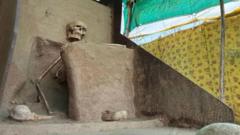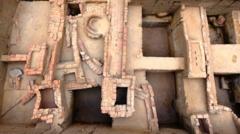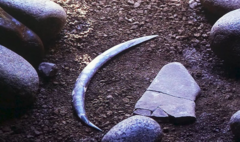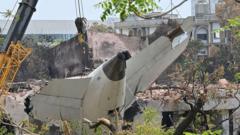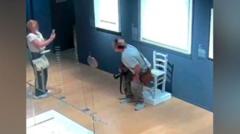Six years after it was unearthed, a 1,000-year-old human skeleton that was discovered sitting cross-legged in Gujarat, India, has finally been transferred to a museum. Previously exposed to the elements under a makeshift tarpaulin shelter since 2019, the skeleton has now been relocated to the Archaeological Experiential Museum in Vadnagar, just a short distance from its original excavation site.
The transport of the skeleton was executed with "utmost care," under the oversight of qualified experts and officials from the Archaeological Survey of India (ASI), which is tasked with preserving archaeological finds. Curator Mahendra Surela indicated that the skeleton is currently situated next to the museum's reception area, protected by a barrier, while plans are being formulated for its final display. There is speculation that it may eventually be moved to the second floor, where a photographic representation of the skeleton already exists.
Archaeologist Abhijit Ambekar, who first discovered the remains, expressed satisfaction at the attention this ancient find is finally receiving. He highlighted the skeleton's rarity, noting that similar artifacts have only been located at three other sites across the nation.
Previously, due to bureaucratic disputes, the skeleton faced prolonged neglect, remaining unguarded and at risk of damage. Experts suggest that the skeleton dates back to the Solanki period, a ruling dynasty from 940 to 1300 CE, and it has survived largely due to the undisturbed soil that surrounded it. Ambekar also pointed out that these remains could provide insights into "samadhi burials," a unique burial practice among revered figures in ancient Hindu culture.
The transport of the skeleton was executed with "utmost care," under the oversight of qualified experts and officials from the Archaeological Survey of India (ASI), which is tasked with preserving archaeological finds. Curator Mahendra Surela indicated that the skeleton is currently situated next to the museum's reception area, protected by a barrier, while plans are being formulated for its final display. There is speculation that it may eventually be moved to the second floor, where a photographic representation of the skeleton already exists.
Archaeologist Abhijit Ambekar, who first discovered the remains, expressed satisfaction at the attention this ancient find is finally receiving. He highlighted the skeleton's rarity, noting that similar artifacts have only been located at three other sites across the nation.
Previously, due to bureaucratic disputes, the skeleton faced prolonged neglect, remaining unguarded and at risk of damage. Experts suggest that the skeleton dates back to the Solanki period, a ruling dynasty from 940 to 1300 CE, and it has survived largely due to the undisturbed soil that surrounded it. Ambekar also pointed out that these remains could provide insights into "samadhi burials," a unique burial practice among revered figures in ancient Hindu culture.

